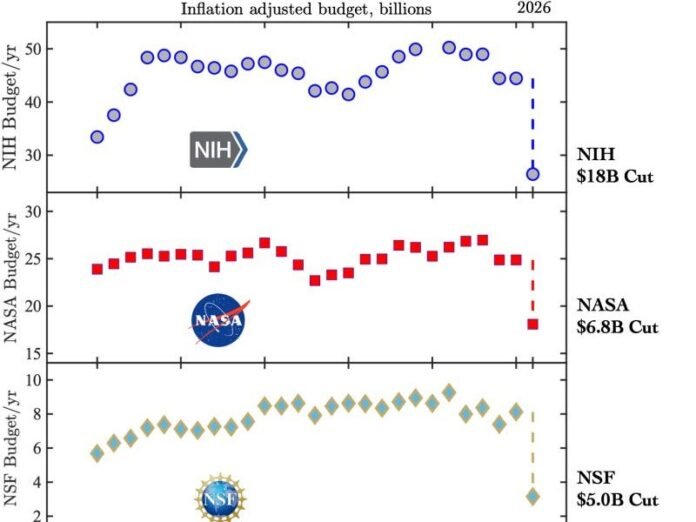Years ago, when I was a professor, I studied how violence spreads through communities (much like infectious diseases) and how to interrupt the spread. My research was funded through federal grants from the National Institutes of Health (NIH) and the National Institute for Occupational Safety and Health (NIOSH). Several federal grants supported my research on the mental health of police officers—people who routinely witness traumatic events that affect not just their well-being (think PTSD), but also how they engage with the communities they serve. Like many researchers, I became involved in this work because it held personal significance for me. My husband was a police officer.
The officers we worked with—many of whom are MAGA supporters (and our dear friends!)—weren’t passive subjects. They were collaborators. They opened their doors, welcomed us into their stations, shared coffee, and helped us ask and answer hard questions. Together, we eventually co-developed solutions that became policy across departments! The same grant that funded this work also supported the training of PhD students, many of whom continue this work today, grounded in relationships they built with officers years ago.
This is the power of public research. When done well, it doesn’t just answer questions; it builds community, capacity, and long-term change for a healthier future.
I’ve been thinking about that project a lot lately. If it were up for funding this year, it would’ve been discontinued due to executive orders. Not one of those officers, regardless of political leaning, would have been okay with it because it was their project, too. However, those officers never really knew NIH/NIOSH was the invisible engine behind the magic.
In just six months, more than 5,500 research projects have been halted. That’s 5,500 unanswered questions. Thousands of communities left behind. Researchers stuck in limbo. And a generation of training lost.
All of this is happening quietly, strategically, and politically. But we in science and public institutions must also own our part: We haven’t done enough to make this work visible to the people it impacts. This invisibility has consequences. Because when people don’t see science working for them, it becomes easy to tear it down.
The good news is it’s not too late. There are real steps we can take now and in the future to change course.
The National Institutes of Health (NIH) is the world’s largest public funder of research. It’s not one agency but a collection of 27 institutes and centers, each focused on specific areas like cancer (NCI), infectious diseases (NIAID), aging (NIA), and mental health (NIMH). NIH isn’t the only research engine in the United States (for example, there’s also the National Science Foundation that funds NASA), but NIH is by far the biggest.
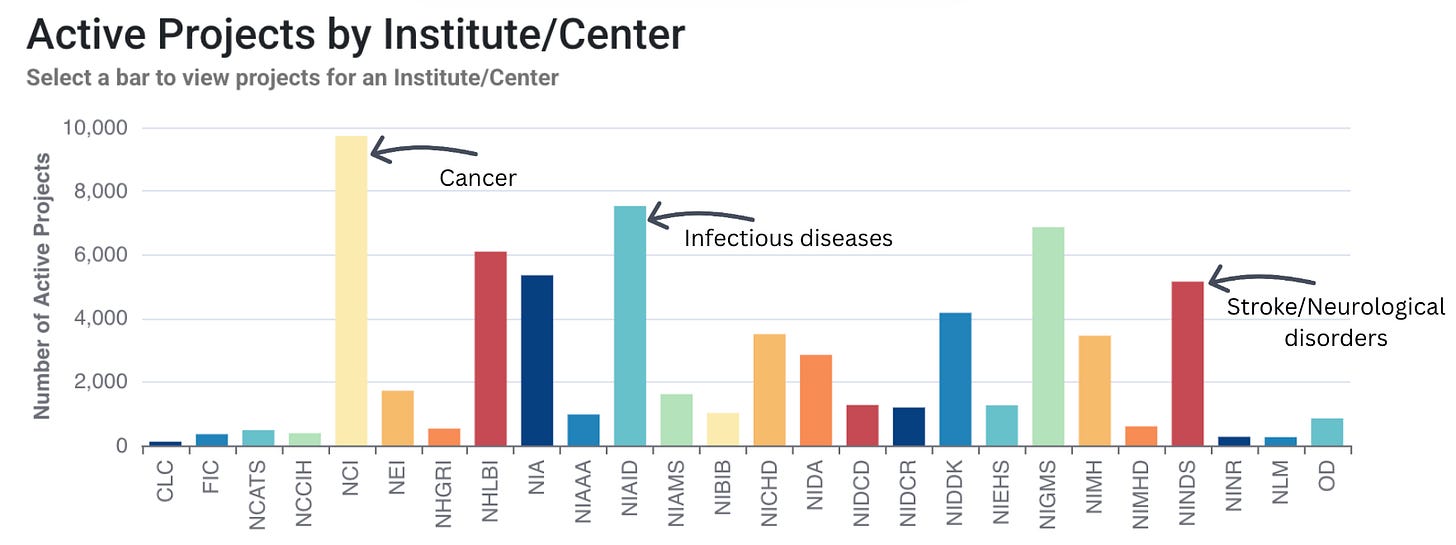
Getting a federal research grant is no small feat. Scientists spend months writing proposals, which are then reviewed rigorously by peers. Only the most promising, relevant, innovative, and well-designed research makes the cut, which is usually only the top 10-20% of applications. Securing a grant is a huge deal for your career. It is often the only way a scientist’s salary is paid, but it is also a guarantee that you’ll work on what you’re most passionate about for a few years.
Research funding budgets rise and fall every fiscal year, depending on Congress’s priorities, but this year is dramatically different. At the NIH alone, approximately 5,500 fewer research projects are being funded due to executive decisions, which is significantly lower than in any other year, as shown below.
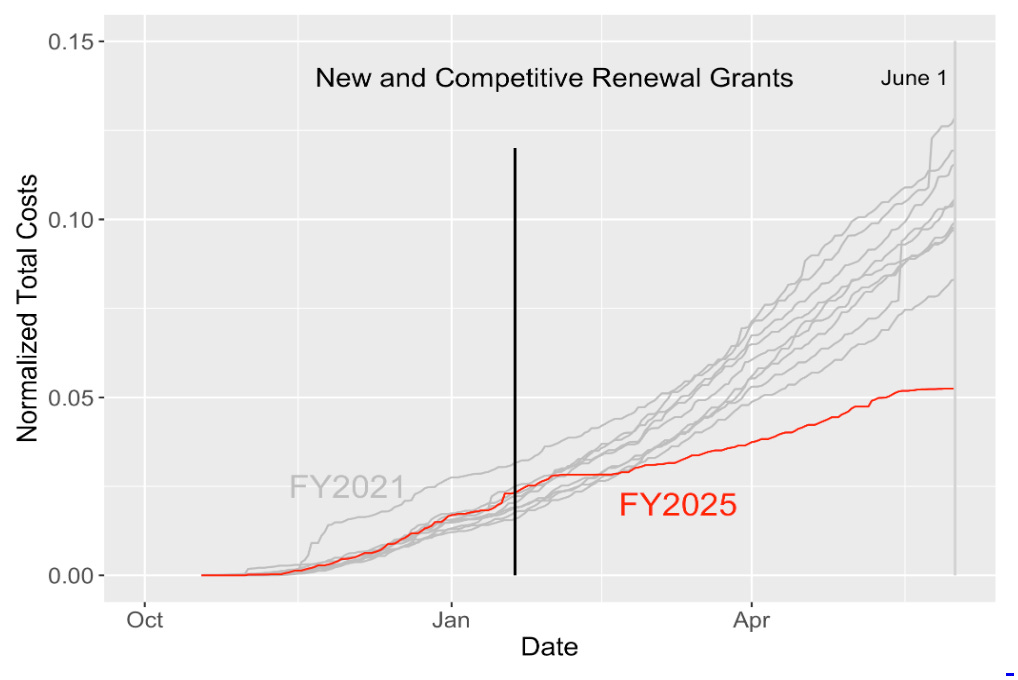
Some of these projects support teaching and training the next generation of researchers, but funding has literally flatlined.
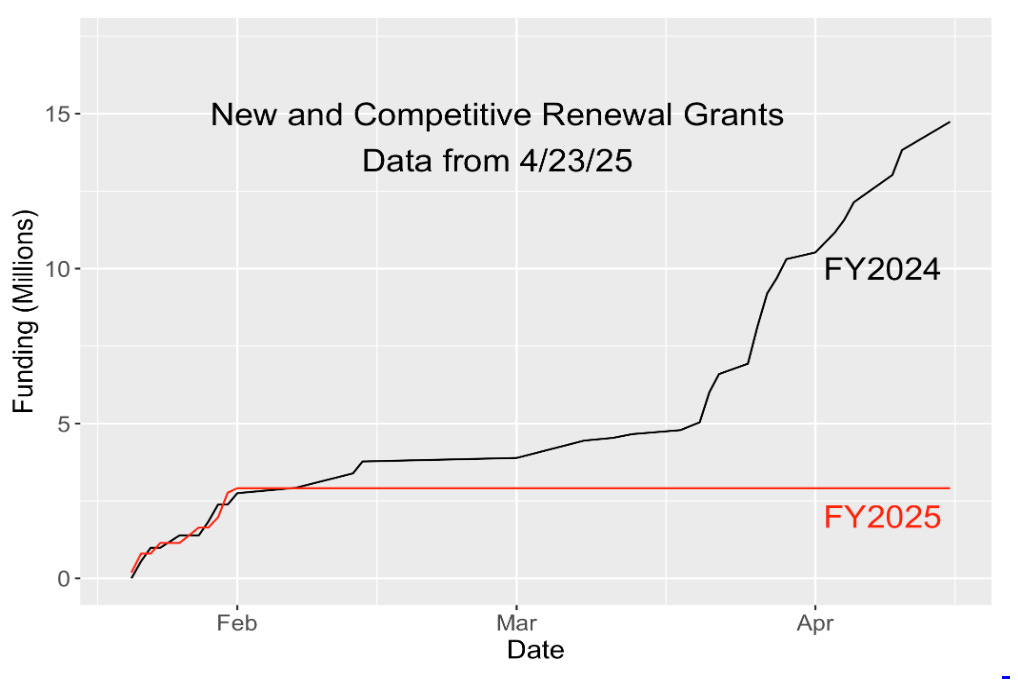
These cuts are currently being made through executive orders in three ways:
-
Cutting entire institutes, such as the Fogarty International Center, which supports global health research and pandemic preparedness.
-
Targeting research topics that don’t align with political agendas, like occupational health (my project), climate and health, LGBTQ+ health, gun violence prevention, healthy equity, misinformation, and vaccine confidence.
-
Targeting specific institutions that get awarded funds, like all grants to the Harvard School of Public Health that were cancelled last month.
And even where programs haven’t been cut outright, they’re in limbo. Peer review panels are stalled. People handling grants (called program officers) are eerily reading from scripts when you call them. Researchers are waiting on funding decisions that should have arrived months ago.
Unfortunately, this is just the beginning. The Congressional budget has proposed an additional 40% cut to the NIH. NIH is the most significant cut in the Health and Human Services discretionary budget. To say that scientific discovery is being stripped to the bare bones is an understatement.
Some politicians portray these cuts as trimming waste or targeting fringe projects that don’t apply to the average American. And, yes, some projects are very niche. But some projects are not. (Here is an ongoing database of cuts.)
For example, more than 100 clinical trials have been cut, even for topics that MAHA supports, such as chronic disease, cancer, diabetes, and mental health.
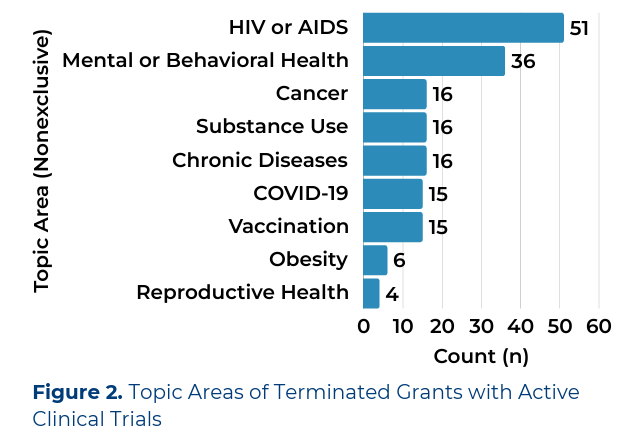
Here’s a sample of research that has been cut so far:
-
Research on long-term exposure to arsenic, and the co-occurrence of uranium, in public and private drinking water
-
Cancer in Your Community: Strategies to Reduce Cancer and Chronic Disease in the Arkansas Delta
-
Automated Digital Imaging for Cervical Cancer Screening
-
Racial Disparity in Diagnostic Evaluation of Uterine Cancer
-
Alzheimer’s Disease Research Center
-
HOPE in Action: A Clinical Trial of HIV-to-HIV Liver Transplantation
-
Alaska Native Communities Advancing Vaccine Uptake
This also impacts local economies. If the NIH budget proposal moves forward, 200,000 jobs will be lost, resulting in $46 billion in economic losses. For each $1 invested in NIH, it returns $2.56 in local economies. For example, the University of Alabama, which receives significant support through the NIH, is the largest employer in the state.
Of course the NIH like all institutions could be improved. Ask any scientist, and you’ll hear it needs reform. But destruction is not the answer.
NIH has long been the invisible force powering vaccines, cancer therapies, diagnostics, and public health breakthroughs. However, that very invisibility—science’s failure to communicate its impact on people’s lives in ways they can see and feel—has made it vulnerable. For decades, much of science communication has lived behind paywalls, wrapped in jargon, distant from the communities it’s meant to serve, even though their tax dollars fund it.
Here are three starting points for reform:
-
Engage the public. NIH is publicly funded. The public deserves a better understanding of what’s being funded, why it matters, and how it’s improving lives. Grant requirements could include plain-language summaries and public-facing updates.
-
Streamline applications. Scientists shouldn’t have to spend months writing proposals for a one-in-five shot. NIH should simplify the application process and improve transparency.
-
Balance funding across disciplines. Behavioral health, social determinants of health (think housing, food insecurity), nutrition, and prevention strategies often get shortchanged despite their real-world relevance.
There are many more ideas out there, too, like workforce improvements and exploring new funding models.
The judicial system is responding. Last month, the U.S. District Court of Massachusetts ruled that the current administration’s decision to terminate NIH grants based on political objections to research topics was unlawful. The ruling only applies to the scientists and in the 16 states named in the lawsuit at this time. The administration could still appeal the decision or potentially ignore the ruling.
This topic is becoming increasingly bipartisan. We can see it in the polls (below). At the Senate HELP committee, Republicans, such as Senator Bill Cassidy, voiced concerns about research projects being cut. Senator Susan Collins, Republican, recently held a committee hearing on NIH achievements, the cuts, and how we can thoughtfully improve these systems.
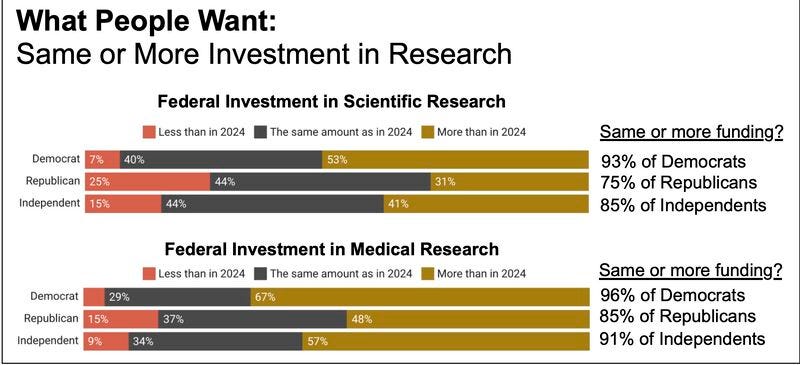
Your voice matters. The FY 2026 budget is still under negotiation and it’s not too late to stop these cuts. Staffers have informed me that it is particularly important to get people calling; a push from constituents before a vote can significantly influence senators’ decisions to vote yes or no. Republicans voters tend to push until the end; Democrats voters tend to peter out.
-
Contact your senators and representatives directly. Two senators in particular—Mike Rounds (SD) and John Kennedy (LA)—are key votes on the budget committee and need encouragement.
And remember, the community is not merely a research target but an active partner. So if you’re a scientist or researcher, share stories:
-
Create an infographic based on your study after you have asked people to complete a survey.
-
Work with a patient organization.
-
Open your lab for community tours.
-
Host a community science storytelling event. Liz Marnik started this event because she knows that science belongs in community spaces, allowing people to see how it connects to their lives. Storytelling makes science personal, relatable and memorable. It helps people see themselves in the science, breaks down barriers, and builds trust in a way data alone can’t.
Federal research is the quiet engine behind the treatments, vaccines, and tools that keep us healthy. Americans are now getting at least 5,500 fewer research questions answered. This should serve as a wake-up call, not just for the public and policymakers, but also for scientists. Because if we want to protect this engine, we have to show people what it does.
Scientific discovery is one hell of a ride. And every American deserves a seat. Just like those police officers. They cared that someone showed up. That someone listened. That science worked for them.
And that’s what we have to fight to preserve.
Love, YLE and LM
Dr. Liz Marnik is an immunologist and Director of Science Education and Outreach at MDI Biological Laboratory. She is also a brilliant scientific communicator and a dear friend of YLE for years.
Your Local Epidemiologist (YLE) is founded and operated by Dr. Katelyn Jetelina, MPH PhD—an epidemiologist, wife, and mom of two little girls. YLE is a public health newsletter that reaches over 375,000 people in more than 132 countries, with one goal: to translate the ever-evolving public health science so that people are well-equipped to make evidence-based decisions. This newsletter is free to everyone, thanks to the generous support of fellow YLE community members. To support the effort, subscribe or upgrade below:



